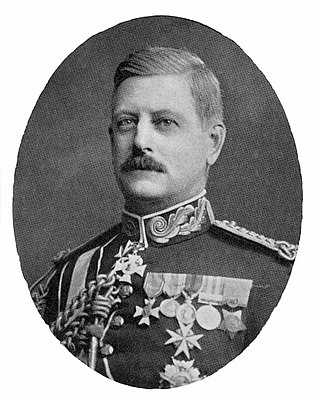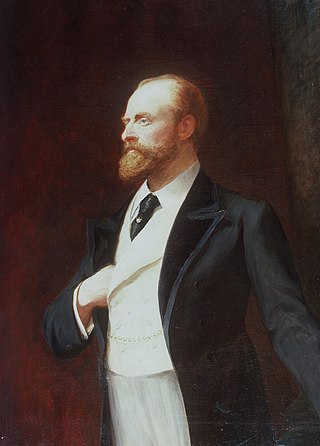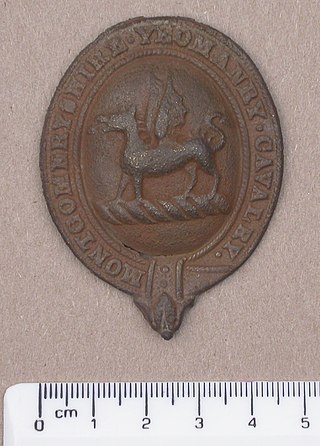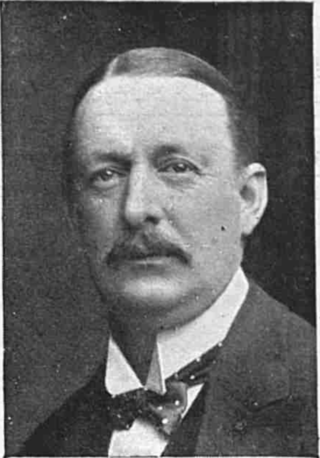Related Research Articles

Machynlleth is a market town, community and electoral ward in Powys, Wales and within the historic boundaries of Montgomeryshire. It is in the Dyfi Valley at the intersection of the A487 and the A489 roads. At the 2001 Census it had a population of 2,147, rising to 2,235 in 2011. It is sometimes referred to colloquially as Mach.

Charles Watkin Williams-Wynn PC was a British politician of the early- to mid-19th century. He held office in both Tory and Whig administrations and was Father of the House of Commons between 1847 and 1850.

George Henry Robert Charles William Vane-Tempest, 5th Marquess of Londonderry, KP, styled Viscount Seaham between 1823 and 1854 and known as The Earl Vane between 1854 and 1872, was a British aristocrat, businessman, diplomat and Conservative politician.

Colonel Lord William Cecil was a British army officer and royal courtier.
Seaham Hall is an English country house, now run as a spa hotel, in County Durham.

Plas Machynlleth is the former Welsh residence of the Marquesses of Londonderry. It is situated in the market town of Machynlleth in Powys, Wales. It was brought into the family following the 1846 marriage of the then Viscount Seaham to Mary Cornelia Edwards, who inherited it on the death of her father, Sir John Edwards, in 1850. Sir John had extended and renamed the house. It is a Grade II* listed building and its gardens, now mainly a public park, are listed on the Cadw/ICOMOS Register of Parks and Gardens of Special Historic Interest in Wales.
The office of High Sheriff of Montgomeryshire was established in 1541 since then a High Sheriff was appointed annually until 1974 when the office was transformed into that of High Sheriff of Powys as part of the creation of Powys from the amalgamation of Montgomeryshire, Radnorshire and Brecknockshire. Between the Edwardian Conquest of Wales in 1282 and the establishment of the High Sheriff of Montgomeryshire in 1541 the sheriff's duties were mainly the responsibility of the coroner and the Custos Rotulorum of Montgomeryshire. The Office of High Sheriff remained first in precedence in the County until the reign of Edward VII when an Order in Council in 1908 gave the Lord Lieutenant of Montgomeryshire the prime Office under the Crown as the Sovereign's personal representative.

Richard Penruddocke Long JP, DL was an English landowner and Conservative Party politician. He was a founding member of the amateur cricket club I Zingari. Long was appointed High Sheriff of Montgomeryshire in 1858 and served as Justice of the Peace as well as Deputy Lieutenant for the county.
This article is about the particular significance of the year 1874 to Wales and its people.
This article is about the particular significance of the year 1846 to Wales and its people.
Sir William Williams, 2nd Baronet, of Glascoed, Llansilin, Denbighshire was a Welsh landowner and Tory politician who sat in the House of Commons from 1708 to 1710.

Edward Herbert, 2nd Earl of Powis, KG, styled Viscount Clive between 1804 and 1839, was a British peer and Tory politician. He was the grandson of Clive of India.
This is a list of Sheriffs of Merionethshire. The historic county of Merioneth was originally created in 1284. The administrative county of Merioneth was created from the historic county under the Local Government Act 1888.

The Montgomeryshire Yeomanry was a Welsh auxiliary unit of the British Army first formed in 1803. It served in home defence and for internal security, including deployments to deal with Chartist disturbances in the 1830s. It provided volunteers to the Imperial Yeomanry during the Second Boer War and formed three regiments for service during World War I. It was broken up and converted to infantry and artillery in 1920.

Charles Stewart Vane-Tempest-Stewart, 6th Marquess of Londonderry,, styled Viscount Castlereagh between 1872 and 1884, was a British Conservative politician, landowner and benefactor, who served in various capacities in the Conservative administrations of the late 19th and early 20th centuries. After succeeding his father in the marquessate in 1884, he was Lord-Lieutenant of Ireland between 1886 and 1889. He later held office as Postmaster General between 1900 and 1902 and as President of the Board of Education between 1902 and 1905. A supporter of the Protestant causes in Ulster, he was an opponent of Irish Home Rule and one of the instigators of the formal alliance between the Conservative Party and the Liberal Unionists in 1893.

Robert Myddelton Biddulph was a British landowner and Member of Parliament for the Liberal Party.
The Baronetcy of Ellis-Nanney of Gwynfryn and Cefndeuddwr was granted to Hugh Ellis-Nanney in 1898. The 1st baronet was a landowner with over 12,000 acres in North Wales, UK, most of which was inherited from his father, Owen Jones Ellis-Nanney. The family were political Conservative party members within the parliamentary constituency of Caernarfon, Wales.
William Mostyn Owen, born William Mostyn, was a British land-owner and politician who sat in the House of Commons from 1774 to 1795.

Lord Herbert Lionel Henry Vane-Tempest, KCVO, was a British company director. He was a director of the Cambrian Railways and died in the Abermule train collision in January 1921.
The Montgomeryshire Militia, later the Royal Montgomeryshire Rifles, was an auxiliary regiment reorganised in the Welsh county of Montgomeryshire during the 18th Century from earlier precursor units. Primarily intended for home defence, it served in Great Britain and Ireland during Britain's major wars. It later became part of the South Wales Borderers until it was disbanded in 1908.
References
- ↑ Montgomeryshire worthies, Williams, Richard, 1894 p 54-55 retrieved 9 September 2015
- ↑ "No. 19631". The London Gazette . 3 July 1838. p. 1488.
- ↑ Bryn Owen, History of the Welsh Militia and Volunteer Corps 1757–1908: Montgomeryshire Regiments of Militia, Volunteers and Yeomanry Cavalry, Wrexham: Bridge Books, 2000, ISBN 1-872424-85-6, pp. 72–4.
- The National Archives, PCC wills, PROB11/2114, Will of Sir John Edwards, proved 1850.
- National Library of Wales, Plas Machynlleth estate records, context and administrative history.
- ThePeerage.com